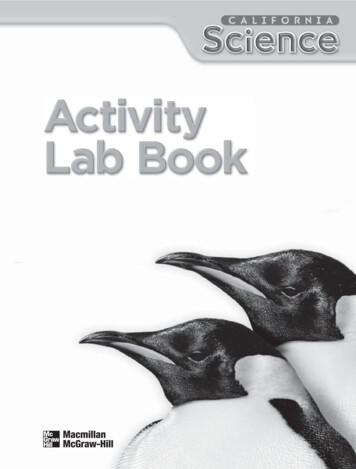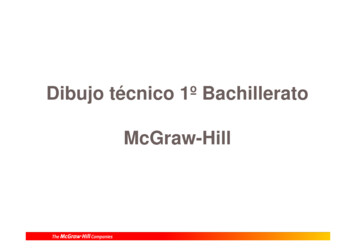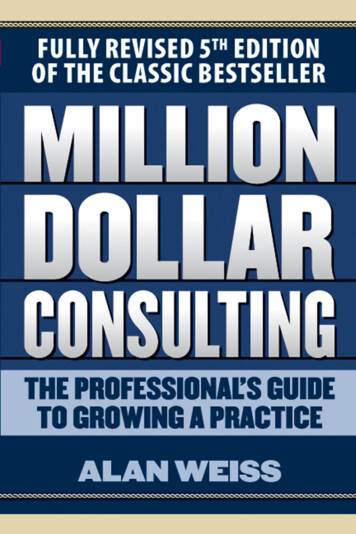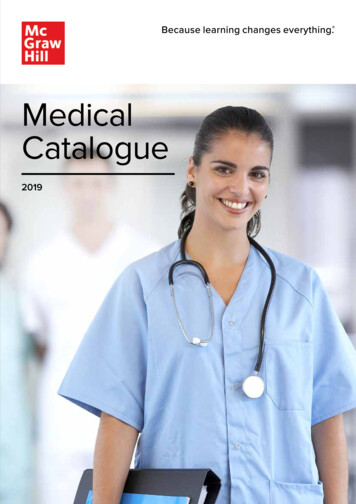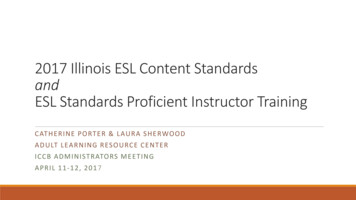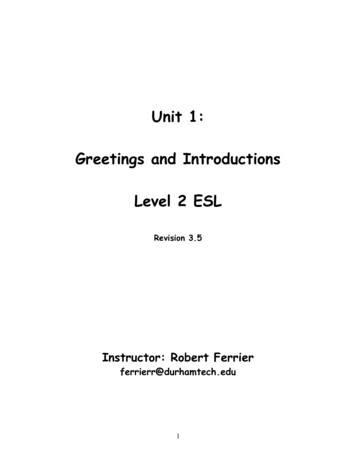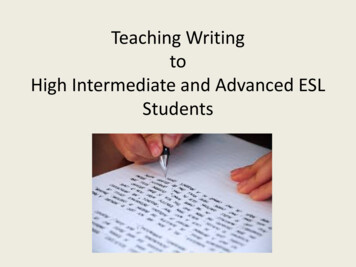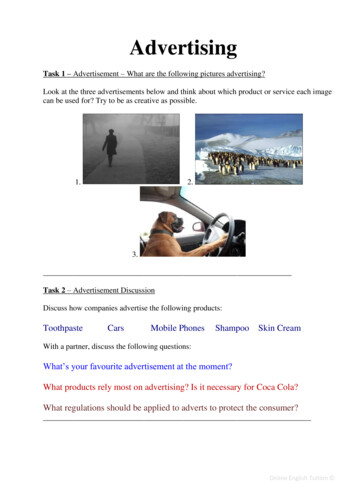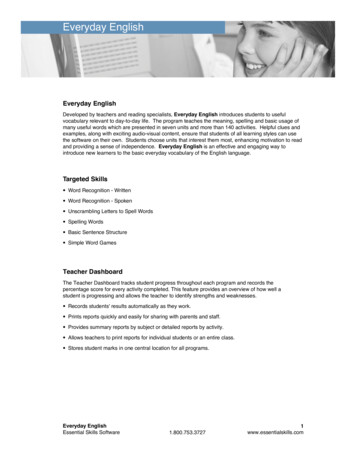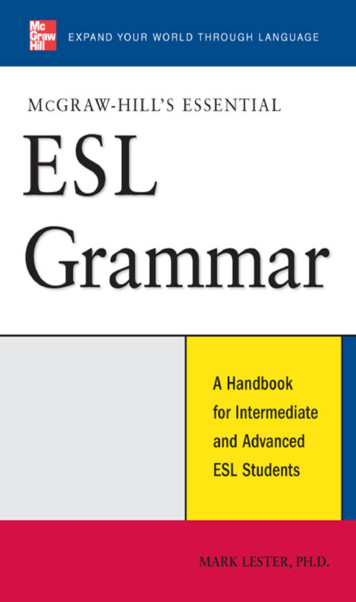
Transcription
M C GR AW-H ILL’S ESSEN T I ALESLGrammarA Handbook for Intermediate and Advanced ESL StudentsMARK LESTER, PH.D.New York Chicago San Francisco Lisbon London Madrid Mexico CityMilan New Delhi San Juan Seoul Singapore Sydney Toronto
Copyright 2008 by Mark Lester. All rights reserved. Manufactured in the United States ofAmerica. Except as permitted under the United States Copyright Act of 1976, no part of thispublication may be reproduced or distributed in any form or by any means, or stored in a databaseor retrieval system, without the prior written permission of the publisher.0-07-164234-XThe material in this eBook also appears in the print version of this title: 0-07-149642-4.All trademarks are trademarks of their respective owners. Rather than put a trademark symbol afterevery occurrence of a trademarked name, we use names in an editorial fashion only, and to thebenefit of the trademark owner, with no intention of infringement of the trademark. Where suchdesignations appear in this book, they have been printed with initial caps.McGraw-Hill eBooks are available at special quantity discounts to use as premiums and salespromotions, or for use in corporate training programs. For more information, please contactGeorge Hoare, Special Sales, at george hoare@mcgraw-hill.com or (212) 904-4069.TERMS OF USEThis is a copyrighted work and The McGraw-Hill Companies, Inc. (“McGraw-Hill”) and its licensors reserve all rights in and to the work. Use of this work is subject to these terms. Except aspermitted under the Copyright Act of 1976 and the right to store and retrieve one copy of the work,you may not decompile, disassemble, reverse engineer, reproduce, modify, create derivative worksbased upon, transmit, distribute, disseminate, sell, publish or sublicense the work or any part of itwithout McGraw-Hill’s prior consent. You may use the work for your own noncommercial andpersonal use; any other use of the work is strictly prohibited. Your right to use the work may beterminated if you fail to comply with these terms.THE WORK IS PROVIDED “AS IS.” McGRAW-HILL AND ITS LICENSORS MAKE NOGUARANTEES OR WARRANTIES AS TO THE ACCURACY, ADEQUACY OR COMPLETENESS OF OR RESULTS TO BE OBTAINED FROM USING THE WORK, INCLUDING ANYINFORMATION THAT CAN BE ACCESSED THROUGH THE WORK VIA HYPERLINK OROTHERWISE, AND EXPRESSLY DISCLAIM ANY WARRANTY, EXPRESS OR IMPLIED,INCLUDING BUT NOT LIMITED TO IMPLIED WARRANTIES OF MERCHANTABILITYOR FITNESS FOR A PARTICULAR PURPOSE. McGraw-Hill and its licensors do not warrantor guarantee that the functions contained in the work will meet your requirements or that itsoperation will be uninterrupted or error free. Neither McGraw-Hill nor its licensors shall be liableto you or anyone else for any inaccuracy, error or omission, regardless of cause, in the work or forany damages resulting therefrom. McGraw-Hill has no responsibility for the content of anyinformation accessed through the work. Under no circumstances shall McGraw-Hill and/or itslicensors be liable for any indirect, incidental, special, punitive, consequential or similar damagesthat result from the use of or inability to use the work, even if any of them has been advised of thepossibility of such damages. This limitation of liability shall apply to any claim or causewhatsoever whether such claim or cause arises in contract, tort or otherwise.DOI: 10.1036/0071496424
ProfessionalWant to learn more?We hope you enjoy thisMcGraw-Hill eBook! Ifyou’d like more information about this book,its author, or related books and websites,please click here.
For more information about this title, click hereContentsIntroduction . . . . . . . . . . . . . . . . . . . . . . . . . . . . . . . . . . . . . . . . vpart I Noun Phrases . . . . . . . . . . . . . . . . . . . . . . . . . . . . . . . . . . . .11234567Nouns . . . . . . . . . . . . . . . . . . . . . . . . . . . . . . . . . . . . . . . . . . . . . . 3Adjectives . . . . . . . . . . . . . . . . . . . . . . . . . . . . . . . . . . . . . . . . . . 21Determiners . . . . . . . . . . . . . . . . . . . . . . . . . . . . . . . . . . . . . . . 29Post-Noun Modifiers . . . . . . . . . . . . . . . . . . . . . . . . . . . . . . . . 49Pronouns . . . . . . . . . . . . . . . . . . . . . . . . . . . . . . . . . . . . . . . . . . 75Gerunds and Infinitives . . . . . . . . . . . . . . . . . . . . . . . . . . . . . . 87Noun Clauses . . . . . . . . . . . . . . . . . . . . . . . . . . . . . . . . . . . . . 103part II Verb Phrases . . . . . . . . . . . . . . . . . . . . . . . . . . . . . . . . . .11989101112131415Basic Verb Forms . . . . . . . . . . . . . . . . . . . . . . . . . . . . . . . . . .Verb Tenses and Modals . . . . . . . . . . . . . . . . . . . . . . . . . . . .Special Verbs . . . . . . . . . . . . . . . . . . . . . . . . . . . . . . . . . . . . . .Verb Complements I: Simple Complements . . . . . . . . . . . .Verb Complements II: Multiple Complements . . . . . . . . . .Predicate Adjective Complements . . . . . . . . . . . . . . . . . . . .Adverbs . . . . . . . . . . . . . . . . . . . . . . . . . . . . . . . . . . . . . . . . . .Using Adverbs . . . . . . . . . . . . . . . . . . . . . . . . . . . . . . . . . . . . .121135169193203223237249part III Sentences . . . . . . . . . . . . . . . . . . . . . . . . . . . . . . . . . . . . .27316 Conjunctions . . . . . . . . . . . . . . . . . . . . . . . . . . . . . . . . . . . . . . 27517 Questions . . . . . . . . . . . . . . . . . . . . . . . . . . . . . . . . . . . . . . . . . 29718 The Passive . . . . . . . . . . . . . . . . . . . . . . . . . . . . . . . . . . . . . . . 319Index . . . . . . . . . . . . . . . . . . . . . . . . . . . . . . . . . . . . . . . . . . . . 335iii
This page intentionally left blank
IntroductionThis book is for nonnative speakers of English who have already attainedextensive fluency in classroom English. It is designed to help you moveto the next level of functioning comfortably in a fully English-speakingenvironment. For example, your job may take you to an English-speakingcountry, or your duties may require you to interact extensively with nativeEnglish speakers in person, on the telephone, or on the Internet.Even though the book includes many topics covered in other ESL books,it is not a textbook. It is an advanced-level reference work designed to giveyou instant access to detailed information about specific topics that youneed to know and apply now. Each section of the book is a self-containedmodule. Unlike with a textbook, you do not need to start on page 1. Justuse the table of contents or the index to locate the topic you need, and thengo right to it.The most important feature of this book is the immense amount ofinformation about English grammar in general and about four specificareas of English grammar that are most likely to cause difficulties: Areas of unusual grammatical complexity. Nonnative speakers fi ndcertain areas of grammar especially difficult to master. The reason is simple: the grammatical mechanisms involved are indeed quite complicated.Unless you fully understand how these mechanisms work, you will nevermaster the areas they govern. This book explains these mechanisms inmuch greater detail than most ESL textbooks attempt to do. Areas of unusual irregularity. Many grammatical options are controlledby particular words, often verbs. This book is full of lists that tell the readerwhich words control which specific grammatical structures. For example,it is impossible to predict in general whether a particular verb will permitvCopyright 2008 by Mark Lester. Click here for terms of use.
viIntroductiona gerund, an infinitive, or both as an object. The only way you can tell is tolook at the lists provided to see which construction is allowable. No otherbook (outside specialized linguistic reference works) provides such extensive listings of idiosyncratic, word-controlled grammatical structures. Areas in which native speakers routinely use special forms in conversational English. If your only use of English is as a formal, written language (as is the case for many nonnative speakers), and you don’t foreseeany need to ever talk to a native speaker of English under fifty years old,then this area is not a concern for you.For everybody else, however, this may well be the most difficult of thefour areas. Unless you have had extensive direct contact with native speakers of English in informal situations, you simply have not had the opportunity to acquire this type of English. It is not just a matter of contractionsand rapid speech (though these will cause you plenty of problems); thereare also well-established, predictable shifts in grammar that take place incasual conversation. Here’s an illustration:In formal English, the standard passive is formed with the helping verbbe. For example:We were interrupted.In informal conversational English, most native speakers actually use thehelping verb get instead of be. For example:We got interrupted.One of the key features of this book is the discussion of this kind of grammatical substitution wherever it is significant. (This occurs surprisinglyoften.) Areas in which both native and nonnative speakers often make mistakes. As you become more like a native speaker, you are bound to startmaking the same mistakes that native speakers do. For example, like nativespeakers, you will have problems distinguishing between restrictive andnonrestrictive adjective clauses in more complicated sentences. You willalso have problems knowing when and how to use direct and indirect quotation. This book has extensive treatments of these predictable problem
Introductionviiareas, far beyond what you would ever encounter in an ESL textbook (andmost books for native speakers, for that matter).This book is divided into three parts: Noun Phrases, Verb Phrases, andSentences.Part I, Noun Phrases: Noun phrases (nouns together with all theirmodifiers) are one of the fundamental building blocks of English. Nounphrases function as the subjects of sentences, the objects or complementsof verbs, and the objects of prepositions. Part I addresses the various components that make up noun phrases. The first four chapters describe nounsand noun modifiers. The remaining three chapters discuss grammaticalentities other than nouns that can also function as noun phrases. They arepronouns, gerund and infinitive phrases, and noun clauses.Part II, Verb Phrases: Part II is devoted to verb phrases, the second ofthe two fundamental building blocks of English. Verb phrases are verbstogether with all of the verbs’ complements (structures required by particular verbs) and optional modifiers. The first three chapters deal specifically with verb forms and verb tenses. The next three chapters dealwith verb complements: nouns, adjectives, adverbs, and other grammaticalstructures that are required by particular verbs and predicate adjectives toform complete sentences. The final two chapters deal with optional adverbmodifiers of verbs.Part III, Sentences: In this section we will examine three topics thataffect entire sentences. These topics have been picked for two reasons:they are a major part of English grammar, but even more important, theypose certain difficulties for nonnative speakers. Chapter 16 explores conjunctions: ways in which words, phrases, and entire independent clauses(sentences) are joined together. Chapter 17 focuses on how questions areformed. We conclude with a study of the passive in Chapter 18.Note: Throughout the text, X signifies ungrammatical, ? signifies questionable, X? signifies borderline ungrammatical, and // signifies thesound of a letter.
This page intentionally left blank
PA RT INoun Phrases1Copyright 2008 by Mark Lester. Click here for terms of use.
This page intentionally left blank
1NounsThis chapter is divided into three sections. The first two sections describein detail the two basic types of nouns: proper nouns and common nouns.Proper nouns are the names of specific individuals; common nouns are thenames of categories. The third section describes how we form possessivenouns.Proper NounsHere are some examples of proper nouns:Specific persons: Dorothy, Miss Marple, Senator Smith, Uncle FredSpecific places: Chicago, Jordan, Red Sea, Mount OlympusSpecific things: New York Times, Microsoft CorporationCapitalization of Proper NounsThe most obvious feature of proper nouns is that they are capitalized.However, the conventions of capitalization are anything but simple. Hereare some of the more important capitalization rules for persons, places,and things:Capitalization of Persons. Capitalize all parts of the name, includingJr. and Sr.:Fred Smith Sr.Martin Luther King Jr.3Copyright 2008 by Mark Lester. Click here for terms of use.
4Noun PhrasesWhen civil, military, religious, and professional titles precede a nameand are used as part of the name, they are capitalized:General PattonPope Benedict XVIPresident BushHowever, if the title follows the name or is used to talk about a person, thenthe title is considered a common noun and is not capitalized. For example,compare the following:Proper noun: Governor Schwarzenegger was reelected.Common:Arnold Schwarzenegger, the governor of California,was an actor.Common:Arnold Schwarzenegger is the governor of California.The names of groups of people (linguistic, religious, racial) are normally capitalized. For example:CatholicsChineseLatinosCapitalization of Places. Geographical terms (for example, street, river,ocean) that are part of a name are also capitalized. For example:Atlantic OceanGreat Barrier ReefDeep CreekLake ErieElm StreetMississippi RiverEmpire State BuildingRocky MountainsThe names of distinct regions are usually capitalized. For example:Mid Atlanticthe Souththe MidwestSoutheast Asia
Nouns5Popular names of places are usually capitalized (and not enclosed inquotation marks). For example:Badlands (South Dakota)Eastern Shore (Chesapeake Bay)Bay Area (California)Fertile CrescentStrangely enough, words derived from geographical names are generallynot capitalized. For example:china (dishes)plaster of parisfrench friesvenetian blindsCapitalization of Things. The complete names of private and publicorganizations of all kinds are capitalized. For example:Cheney High SchoolPeace CorpsGreen Bay Packers (football team)Xerox CorporationNew York PhilharmonicThe names of historical, political, and economic events are generallycapitalized. For example:Boston Tea PartyNew DealGreat DepressionThe names of acts, treaties, laws, and government programs are generally capitalized. For example:Declaration of IndependenceMarshall PlanFederal Housing ActMonroe DoctrineThe names of months and the days of the week are capitalized, but notthe names of the seasons. For example:fallsummerFebruaryWednesdayspringwinter
6Noun PhrasesPlural Forms of Proper NounsPlural proper nouns are uncommon, not because there is any grammaticalrestriction on them, but because we rarely need to use them. Here are someexamples of plural proper nouns:We have had three hot Julys in a row.The Smiths went to the beach this weekend.There are two New Yorks, one for the rich and another for the rest ofus.Do not use an apostrophe for the plural of proper nouns. For example:X We have known the Johnson’s for a long time.For the use of definite articles with plural proper nouns, see Chapter 3.Common NounsCommon nouns refer to persons, places, things, and ideas (abstractions).Here are some examples:Persons:Places:Things:Ideas:student, women, reporter, father, employeecity, river, mountains, forest, sidewalkcomputer, book, water, elephantjustice, love, friendship, honesty, respectCommon nouns are divided into two main categories: noncount andcount. Noncount nouns are nouns that cannot be used in the plural. Theterm noncount refers to the fact that these nouns are literally not countable;that is, they cannot be used with number words. Most common nouns arecount nouns; they can be counted and used in the plural. The distinctionbetween noncount and count nouns is of particular importance in determining which article to use. This topic is covered in detail in Chapter 3.
Nouns7Noncount NounsMany noncount nouns are generic names for categories of things. Forexample, the noncount noun luggage is a generic or collective term thatrefers to an entire category of objects that we use for carrying things whilewe travel, such as backpacks, briefcases, handbags, suitcases, and valises. Thegeneric noun luggage is not countable, while all of the specific nouns arecountable:Noncount: X one luggage, two luggagesCount:one backpack, two backpacksone briefcase, two briefcasesone handbag, two handbagsone suitcase, two suitcasesMost noncount nouns fall into one of ten semantic categories:Abstractions:Academic fields:Food:Gerunds (-ing verbforms used as nouns):Languages:Liquids and gases:Materials:Natural phenomena:Sports and games:Weather words:beauty, charity, faith, hope, knowledge,justice, luck, reliabilityanthropology, chemistry, economics,literature, physicsbutter, cheese, chicken, pepper, rice, salthoping, running, smiling, winningArabic, Chinese, English, Russian, Spanishbeer, blood, coffee, gasoline, water, air,oxygencement, glass, gold, paper, plastic, silk,wood, woolelectricity, gravity, matter, spacebaseball, chess, football, poker, soccer,tennisfog, pollution, rain, snow, windMany noncount nouns can be used as count nouns but with a predictable shift in meaning—to convey something like “different kinds of.” Hereare some examples:
8Noun Phrasesgasoline—noncount: The price of gasoline is outrageous. (liquid)gasoline—count:The station sells three gasolines. (differentgrades of gasoline)Spanish—noncount: I am learning Spanish. (language)Spanish—count:There are several Spanishes in America.(different kinds of Spanish)cheese—noncount:cheese—count:I love cheese. (food)The store sells a variety of cheeses. (differentkinds of cheese)Some noncount nouns have count noun counterparts but with differentmeanings. Here are some examples:iron—noncount:iron—count:The chain is made of iron. (material)The hotel will provide irons. (electric appliancesfor pressing clothes)paper—noncount:paper—count:Books are made of paper. (material)I left my papers on the desk. (documents)chicken—noncount: Chicken is a heart-healthy meat. (food)chicken—count:There were a dozen chickens in the yard. o much coffee makes me nervous. (liquid)We would like two coffees, please. (cups orservings of coffee)Plural Forms of Count NounsThe distinctive feature of count nouns is that they can be used in the plural. Most nouns form their plural with -(e)s, but there are also a number ofirregular plural forms. Most irregular plurals are either nouns of English
Nouns9origin that have retained older ways of forming the plural or Latin wordsthat have retained their Latin plurals. In addition, there are a small numberof plural-only nouns, and finally there is a difference between British andAmerican English on whether collective nouns are singular or plural.Regular Plurals. The regular plural is most often written as -s. If the regular plural is pronounced as a separate syllable, the regularplural is spelled -es. For oxesclassclasseswishwishesThere are two special spelling rules for regular plurals:Words ending in a consonant y. When a word ends in a consonant y,the plural is formed by the following rule:CHANGE THE Y TO I AND ADD sstorystoriesHowever, if the word ends in a vowel plus y, the preceding rule does notapply, because the letter y is does not represent a separate vowel. The y ispart of the spelling of the vowel and therefore cannot be changed:
10Noun rds ending in a consonant o. There are two spellings for words thatend in a consonant o. In one group, the plural is formed by adding -sin the normal way. In a second group, the plural is formed by adding -es.Unfortunately, there is no way to predict the group to which any particularword belongs. You simply have to look up each word ending in a consonant o. Here are some examples of each group:-s Plurals-es rozerosvolcanovolcanoesIrregular Plurals of English Origin. Seven words form their plural bya vowel change alone:SingularPluralfootfeet (See womanwomenNote: In addition to the usual plural form feet, the noun foot has a secondplural form, foot, when we use the word to refer to length or measurement.For example:
Nouns11I bought a six-foot ladder.He is six foot three inches tall.Some words ending in f form their plurals by changing the f to v andadding -es. Here are the most common words that follow this veslifelivesloafloavesselfselves (also the plural themselves)thiefthieveswolfwolvesSome words have a plural form that is identical to their singular form.Most of these words refer to animals or fish. For example:SingularPlurala codtwo coda deertwo deera fishtwo fisha sheeptwo sheepa shrimptwo shrimpa trouttwo troutSince the singular and plural forms of these nouns are identical, theactual number of the noun can be determined only by subject-verb agreement or by the use of an indefinite article. For example:Singular:Plural:Singular:Plural:The deer was standing in the middle of the road.The deer were moving across the field.I saw a deer in the backyard.I saw some deer in the backyard.
12Noun PhrasesIf one of these words is used as an object with a definite article, then thenumber is inherently ambiguous. For example:Look at the deer! (one deer or many deer?)Two words retain the old plural ending -en:SingularPluralchildchildrenoxoxenIrregular Plurals of Latin Origin. English uses thousands of words ofLatin origin. In formal or scientific writing, the original Latin forms of theplural are often used. While the irregularity of Latin grammar is almostbeyond belief, there are two patterns that are regular enough to merit ourattention:Plurals of Latin words ending in -us. The plurals of these words typicallyend in -i. For ocistimulusstimulisyllabussyllabiPlurals of Latin words ending in -um. The plurals of these words typically end in -a. For riculadatumdata (See ata
Nouns13Note: Data is often used as a kind of collective singular except in formalscientific papers. For example:The data is very clear in this matter.Plural-Only Nouns. Some plural nouns have no corresponding singularform at all or else have a singular form that differs substantially from themeaning of the plural.One group of plural-only nouns refers to tools or articles of clothingthat have two equal parts joined together:Tools:Clothing:bellows, binoculars, (eye)glasses, forceps, pincers,scissors, sheers, spectacles, tongs, tweezersbraces, briefs, flannels, jeans, pants, pajamas, shorts,slacks, suspenders, tights, tops, trousers, trunksHere are some other plural-only nouns with idiomatic meanings:accommodations (living arrangements)funds (money)arms (weapons)guts (courage)brains (intellect)looks (appearance)communications (means of communication)manners (behavior)credentials (records or documents)pains (trouble, effort)customs (duty)wits (intelligence)A few plural-only nouns have no plural marking: cattle, livestock, poultry,people, police. Here are some examples with the plural verb underlined:The police are investigating the crime.People were beginning to talk.Collective NounsCollective nouns refer to groups of people either individually or collectively. Here are some examples:
14Noun ly, we can think of a team, for example, as being either a unit (singular) or a group of individuals (plural). In American English, collectivenouns are almost always treated as singular nouns; in British English, collective nouns are almost always treated as plural nouns. For example, compare the following sentences with the verbs underlined:American:British:The team is on the field.The team are on the field.American:British:The American government has announced a new policy.Her Majesty’s government have announced a new policy.Possessive Forms of NounsModern English is a hybrid of two languages: Old English (Anglo-Saxon)and French. Reflecting this mixed heritage, Modern English has two waysof forming the possessive: the Old English way, which uses an inflectionalending ( ’s and s’), and an of possessive that is a kind of loan-translation ofthe French way of forming the possessive. Here is an example of each:Inflectional possessive:Of possessive:Shakespeare’s playsthe plays of ShakespeareInflectional PossessivesIt is essentially a historical accident that the regular plural and the possessive inflections are pronounced exactly alike, with the same sibilantsounds. Up until the sixteenth century, the plural and the possessives werealso spelled alike: -s. During the sixteenth century, however, the apostrophe began to be used for the possessive ending to distinguish it from theplural ending. For example:
dsfriend’s15The use of the apostrophe after the -s to signal the possessive use of a plural noun did not become widely accepted until the nineteenth century:PluralPlural �While it is correct to call -s’ the “plural possessive,” it is a mistake tothink of the -’s as the “singular possessive.” The problem with this definition arises with the possessive forms of irregular nouns that become pluralby changing their vowel rather than by adding a plural -s. For ildchild’schildrenchildren’sAs you can see, -’s is used with these plural possessive nouns, not -s’. Usingthe -s’ with these nouns would mean (incorrectly, of course) that the /s/is what makes these nouns plural. What actually makes them plural is thechange in their vowels.A much better way to think of plurals and possessive is as follows:Plural OnlyPossessiveOnlyBoth Pluraland Possessive-s-’s-s’This analysis will help ensure that you will always use the right form.Mercifully, the spelling of the possessive forms is regular (though thereare a few exceptions for proper nouns, which are discussed later in this
16Noun Phrasessection). Here are some examples using words that form their plurals indifferent ways.WORDS ENDING IN A CONSONANT es’WORDS ENDING IN es’Notice that in the last two examples, the singular possessive and the pluralforms are spelled differently.WORDS ENDING IN �The possessives of some proper nouns ending in a sibilant sound areoften spelled with just an apostrophe. For example:In Jesus’ name (this spelling is conventional)Ramses’ tombCharles Dickens’ novelsKansas’ main city
Nouns17The Meaning of the Inflectional Possessive. As its name would suggest,the possessive is most commonly used to show ownership or possession.For example:Ralph’s carMy family’s houseHowever, the possessive is used in many other meanings, the two mostimportant being relationships and measurement:RelationshipsRalph’s neighbor (Ralph does not own his neighbor.)My family’s doctor (The family does not own the doctor.)MeasurementTime: an hour’s delay; a week’s postponement; two years’ durationValue: the euro’s value; the dollar’s decline; five dollars’ worthOf PossessiveWhile the inflectional possessive and the of possessive mean the samething, they are not always interchangeable. For example:Inflectional possessive:Of possessive:Inflectional possessive:Of possessive:Sarah’s taxiX the taxi of SarahX a soup’s bowla bowl of soupLet us use the term possessive noun to refer to both (a) nouns that canhave inflectional possessive ’s or s’, and (b) nouns that follow of. In the firstof the preceding examples, the possessive noun would be Sarah. In thesecond example, the possessive noun would be soup.Here is a general rule that will help you decide which form of the possessive noun to use:If the possessive noun is animate, use the inflectional possessive.If the possessive noun is inanimate, use the of possessive.
18Noun PhrasesHere are some examples with animate possessive nouns:Inflectionalthe gentleman’s hatthe cat’s dishour family’s houseOf PossessiveX? the hat of the gentlemanX the dish of the catX the house of our familyHere are some examples with inanimate possessive nouns:Of Possessivea map of Australiaa glass of waterthe back of the roomInflectionalX? Australia’s mapX water’s glassX the room’s backAs with most broad generalizations, the rule about possessives is overlyblack-and-white. The fi rst part, which says that animate nouns requirethe inflectional possessive, does seem to hold true. The real problem iswith the second part, which says that inanimate nouns use only the ofpossessive.We can (but do not have to) use the inflectional possessive with the following types of inanimate nouns:Inanimate possessive nouns that are a product of human creation. Forexample:InflectionalOf Possessivethe ecomony’s growththe growth of the economythe performance’s successthe success of the performancethe game’s rulesthe rules of the gameNatural phenomena. For example:InflectionalOf Possessivethe storm’s damag
The most important feature of this book is the immense amount of information about English grammar in general and about four specifi c areas of English grammar that are most likely to cause diffi culties: Areas of unusual grammatical complexity. Nonnative speakers fi nd certain areas of
